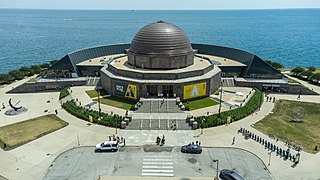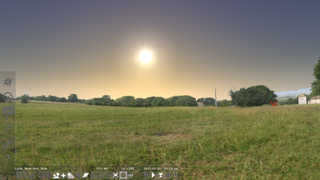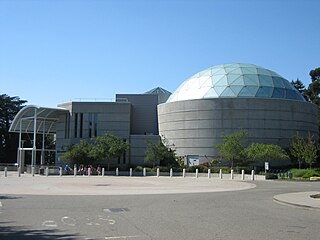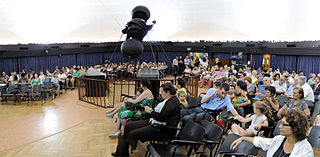 Display of the constellations Orion and Taurus | |
 | |
| Established | 1979 |
|---|---|
| Location | Reims, France |
| Coordinates | 49°14′34″N4°00′56″E / 49.242847°N 4.015628°E |
| Type | Planetarium |
The Planetarium of Reims is the second oldest planetarium in France.
 Display of the constellations Orion and Taurus | |
 | |
| Established | 1979 |
|---|---|
| Location | Reims, France |
| Coordinates | 49°14′34″N4°00′56″E / 49.242847°N 4.015628°E |
| Type | Planetarium |
The Planetarium of Reims is the second oldest planetarium in France.
The Reims planetarium is a place for the dissemination of scientific culture, and more particularly of astronomy to schoolchildren and the general public. The projection system allows you to observe the movements of the Moon, planets and stars, and learn to recognize the constellations.
The first planetarium was installed on Place Museux in the historic setting of the Old Jesuit College, an architectural ensemble from the 17th century, where it operated from March 1, 1980 to January 6, 2013. The room measured 6 meters in diameter, with a capacity of 40 seats. It was equipped with a Zeiss ZKP2 astronomical projector. Over time, the projector was supplemented with a multimedia device (slide projectors, computers, video projectors, special effects projectors) in order to make the sessions more lively and to allow the facilitators to have more teaching aids ( pictures, videos). The average annual attendance was 26,000 visitors (school and general public). In 2003, it celebrated its 500,000th visitor.
The new planetarium was opened to the public on September 7, 2013, after 18 months of work at a cost of 3.4 million euros, in new premises, [1] located at 49, rue du Général-de-Gaulle, in Reims. The elliptical-shaped building is by the architect Jean-Paul Bonnemaisson. The building is treated as an autonomous object, like a solitary star reflecting, moreover in the image of the machines leaving to explore space; connection by footbridges which brings visitors like astronauts boarding a rocket, installation on stilts, shine of the skin made of glass scales like the heat shield of space shuttles. [2] The cylinder under the building received a varnished okoumé skin. At night, all of this glass skin is the support for the staging of some of the 88 constellations and their movements, by setting up a grid of light points based on Leeds. [3]
The new air-conditioned dome measures 8 meters in diameter for a capacity of 48 very comfortable seats plus two places for people with reduced mobility. It is equipped with a Zeiss ZKP4 astronomical projector with optical fibers (cost €450,000), and a multimedia system comprising three high-definition DLP projectors. The projection room is complemented by a scenographic space of nearly 200 m2. The planetarium database allows you to place the sky at a specific moment in history, such as the position of the stars during the French Revolution in 1789. [4]

A planetarium is a theatre built primarily for presenting educational and entertaining shows about astronomy and the night sky, or for training in celestial navigation.

The Adler Planetarium is a public museum in Chicago, Illinois, dedicated to astronomy and astrophysics. It was founded in 1930 by local businessman Max Adler. Located on the northeastern tip of Northerly Island on Lake Michigan, the Adler Planetarium was the first planetarium in the United States. It is part of Chicago's Museum Campus, which includes the John G. Shedd Aquarium and The Field Museum. The Planetarium's mission is to inspire exploration and understanding of the universe.

Stellarium is a free and open-source planetarium, licensed under the terms of the GNU General Public License version 2 or any later version, available for Linux, Windows, and macOS. A port of Stellarium called Stellarium Mobile is available for Android, iOS, and Symbian as a paid version, being developed by Noctua Software. These have a limited functionality, lacking some features of the desktop version. All versions use OpenGL to render a realistic projection of the night sky in real time.

The Fernbank Science Center is a museum, classroom, and woodland complex located in Atlanta. It is owned and operated by the DeKalb County School District, which announced in May 2012 it was considering closing the facility to cut its annual budget, then quickly shelved the plan after public outcry. The nearby Fernbank Museum of Natural History is a private non-profit organization that is separate from the Science Center.

The William M. Staerkel Planetarium is a planetarium at Parkland College in Champaign, Illinois. It is the second largest planetarium in the state, the largest being the Adler Planetarium in Chicago, and has the first Carl Zeiss M1015 opto-mechanical star projector installed in the western hemisphere. The Staerkel Planetarium provides science education programs and light show entertainment to as many as 40,000 people each year. It has a 50-foot dome, seats 144, and private group and school show reservations can be made beyond the regular public offerings.

The McLaughlin Planetarium is a former working planetarium whose building occupies a space immediately to the south of the Royal Ontario Museum in Toronto, at 100 Queen's Park. Founded by a grant from philanthropist Colonel R. Samuel McLaughlin, the facility was opened to the public on October 26, 1968. It had, for its time, a state-of-the-art electro-mechanical Zeiss planetarium projector that was used to project regular themed shows about the stars, planets, and cosmology for visitors. By the 1980s the planetarium's sound-system and domed ceiling were used to display dazzling music-themed laser-light shows. The lower levels of the planetarium contained a gallery called the "Astrocentre" that featured space-related exhibits, related artifacts on the history of astronomy and was also home of the world's first commercial Stellarium

A planetarium projector, also known as a star projector, is a device used to project images of celestial objects onto the dome in a planetarium.

Kyiv Planetarium in Kyiv, Ukraine is one of the largest planetaria in former Soviet states. Opened on January 1, 1952, by the initiative of the scientist-astronomer Serhiy Vsekhsviatskiy (1905–1984), the planetarium has a dome of 23.5 meters in diameter, and seats 320 people.

Chabot Space and Science Center, located in Oakland, California, is a center for learning in Earth and space science, which features interactive exhibits, planetariums, a large screen theater, hands-on activities, and three powerful telescopes.

The Sir Thomas Brisbane Planetarium is located on the grounds of the Brisbane Botanic Gardens in the suburb of Mount Coot-tha, Brisbane, Queensland, Australia. The Planetarium was officially opened on 24 May 1978.

Armand Neustadter Spitz was an American planetarium designer.
Bryan-Gooding Planetarium in the Alexander Brest Science Theatre is a planetarium in the Museum of Science and History in Jacksonville, Florida, U.S. It was built in 1988 and featured a 60-foot-diameter (18 m) dome-shaped projection screen, JBL stereo sound system, and a Zeiss Jena Optical mechanical planetarium star projector. The facility has seating for 200, and approximately 60,000 people see a planetarium show each year.

The Brussels Planetarium of the Royal Observatory of Belgium is a planetarium located on the Heysel/Heizel Plateau in Laeken. It was established during the Brussels International Exposition of 1935 as the Alberteum and is now part of the institutions of the Belgian Federal Science Policy Office.

Observatory Robert A. Naef is an astronomical observatory located at Épendes, Canton of Fribourg, Switzerland at 7.13938 degrees east of Greenwich and 46.76236 degrees north latitude. Its parallax constants are : ρ sin φ' = 0.68632 and ρ cos φ' = +0.72501.

The Astronaut Memorial Planetarium and Observatory, or AMPO, also known as the Eastern Florida State College Planetarium and Observatory, was an astronomical observatory and planetarium at Eastern Florida State College in Cocoa, Florida. The facility consisted of a planetarium, public observatory, large-screen movie theater, exhibit halls, multi-media classroom and an art gallery.

The Nantes Planetarium is a public planetarium that opened on 18 June 1981. It operates as an auditorium that presents astronomy shows for all audiences.

B. M. Birla Planetarium is a large planetarium in Chennai, India. The fifth B. M. Birla planetarium in the country, it is located at Kotturpuram in the Periyar Science and Technology Centre campus which houses eight galleries, namely, Physical Science, Electronics and Communication, Energy, Life Science, Innovation, Transport, International Dolls and Children and Materials Science, with over 500 exhibits. Built in 1988 in the memory of the great industrialist and visionary of India B. M. Birla, it is considered the most modern planetarium in India, providing a virtual tour of the night sky and holding cosmic shows on a specially perforated hemispherical aluminium inner dome. Other Birla planetariums in India include the M. P. Birla Planetarium in Kolkata, the Birla Planetarium in Hyderabad, and the planetariums in Tiruchirapalli and Coimbatore.

Belgrade Planetarium is one of two planetariums in Serbia. It is located in Belgrade and is operated by the Astronomical Society Ruđer Bošković. Before 1967 it was known as the "Turkish bath in Lower Town".

The Birla Planetarium in Kolkata, West Bengal, India, is a single-storeyed circular structure designed in the typical Indian style, whose architecture is loosely styled on the Buddhist Stupa at Sanchi. Situated at Chowringhee Road adjacent to the Victoria Memorial, St. Paul's Cathedral and the Maidan in Central Kolkata, it is the largest planetarium in Asia and the second largest planetarium in the world. There are two other Birla Planetariums in India: B.M. Birla Planetarium in Chennai and the Birla Planetarium in Hyderabad.

Abrams Planetarium is the planetarium on the campus of Michigan State University, Michigan, United States.